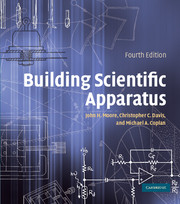7 - DETECTORS
Published online by Cambridge University Press: 05 August 2012
Summary
Phenomena that are studied experimentally often manifest themselves as sources of electromagnetic radiation or particles. To be useful, the radiation or particles that are involved in the experiment must be detected. In this chapter we will consider the operating characteristics, selection criteria, and performance of various types of radiation and particle detectors. We will focus primarily on detectors of optical radiation, from X-rays to far infrared, and on charged-particle detectors. For a discussion of detectors of high-energy photons, such as γ rays, and elementary particles, such as neutrons, neutrinos, and the many particles involved in high-energy nuclear physics, we refer the reader to the more specialized treatises on these subjects.–
OPTICAL DETECTORS
Optical detectors of various kinds detect electromagnetic radiation from the X-ray to the far-infrared region of the electromagnetic spectrum. In common with other branches of electronics, the development of optical detectors has occurred by a series of advances through the use of gas-filled tubes and vacuum tubes to various semiconductor devices. Gas-filled and vacuum-tube devices still retain some niche electronics applications, such as high-voltage switching, microwave power amplification, and specialized audio. Gas-filled photodetectors, which offer some degree of signal amplification in low-cost consumer applications, have essentially disappeared. Vacuum-tube photodetectors, especially photomultiplier tubes, remain in wide-spread use for detection of radiation below about 1 μm. This is especially true for low-light-level signal detection (photon counting), and in applications where a large detector area is required (as in scintillation counters).
- Type
- Chapter
- Information
- Building Scientific Apparatus , pp. 547 - 599Publisher: Cambridge University PressPrint publication year: 2009

